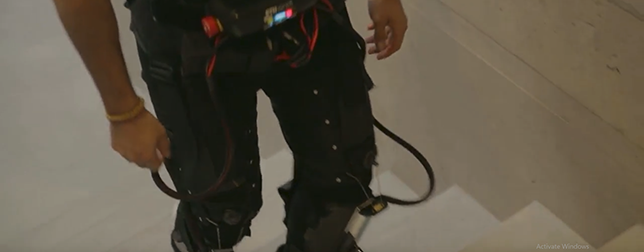People with genetic disorders, neurological injuries or simple aging can experience muscle weakness which affects their mobility and quality of life. Many of these individuals seek help form assistive devices to regain mobility and independence. These devices range from simple wheelchairs to more advanced exoskeletons and exosuits.
For assistive devices to be used in everyday life, they must provide help across activities of daily living (ADLs) in an unobtrusive manner.
Read more Designing Exoskeletons to Interact with Humans
Scientists in Switzerland have developed Myosuit, a soft, wearable device designed to provide continuous assistance at the hip and knee joint when working with and against gravity in ADLs. This assistive device supports people with muscle weakness, including people with myopathy, stroke patients, spinal cord injury, or just elderly who are just too weak to move and climb stairs for example.
This robotic device is a combination of active and passive elements with a closed-loop force controller designed to behave like an external muscle (exomuscle) and deliver gravity compensation to the user. It is one of the lightest untethered devices (weighing only 4.6 kg with batteries) capable of delivering support to the wearer’s knee and hip joints.
How does Myosuit work?
The Myosuit device is very easy to put on and put off. You just wear them like pants, but it’s not passive pants it’s actuated pants. So after you put on the pants you just have to connect the cables, then you can just stand up walk while you’re actively supported by the device. The device is made out of 3 layers which is very similar to human body. First there’s a stabilizing garment layer which keeps the body upright against gravity. The second layer is passive ligament layer which provides stability in different joints against falling down. And the third layer is an active powered layer where motor is used to produce torques in the electrons so it can lift the body against gravity.
The study
A study published in the PubMed tested the Myosuit with a single subject who performed sitting transfers, one of the most gravity-intensive ADLS.
Read more Kessler Foundation and Virtualwear Team Up to Improve Recovery Outcomes in Stroke Patients
The results showed that the device can successfully identify changes in the posture and assist hip and knee extension with up to 26% of the natural knee moment and up to 35% of the knee power. The researchers concluded that the Myosuit’s novel approach to assistance using a bi-articular architecture, in combination with the posture-based force controller, can effectively assist its users in gravity-intensive ADLs, such as sitting transfers.
“The novelty of the myosuit device is that we have chosen a soft structure that’s very lightweight. This allows the patients who are usually bound to a wheelchair get up, walk, climb stair, and descend stairs. This way they can participate in several activities of daily life,” said Professor Robert Reiner, one of the authors of the study.













